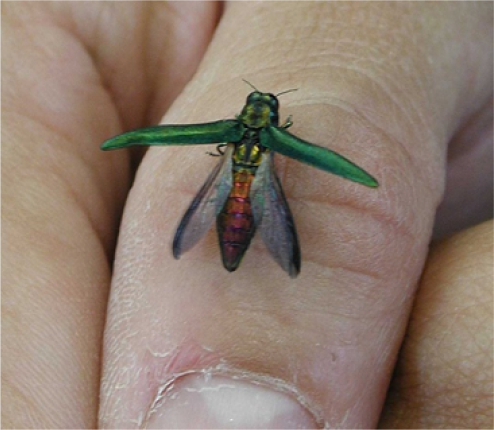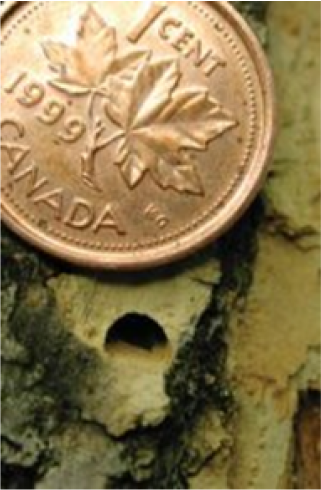Identification
The Emerald Ash Borer, Agrilus planipennis (EAB) is a wood-boring Jewel Beetle native to East Asia and Eastern Russia. It was accidentally introduced in North America from infested solid wood packaging material likely from overseas shipping containers.
It measures 8.5-14 mm long and 3-3.5 mm wide and feeds exclusively on true ash trees (Fraxinus spp.), not mountain ash (Sorbus). They have large compound eyes, short antennae and a coppery-red abdomen beneath each elytron. Adult beetles can fly up to 10 km. For a simple comparison, EAB is roughly the size of a grain of rice.

Pest Lifecycle
They have a two-year lifecycle with adult female beetles laying 40-90 eggs in bark crevices of host trees measuring approximately 1 mm. When the eggs hatch, the larvae bore into the vascular tissues, creating S-shaped feeding galleries in the inner bark and sapwood. Their feeding activity girdles the tree, disrupting water and nutrient flow. Adults emerge from late May to July, leaving distinctive D-shaped exit holes about 1/8″ wide. They feed on ash leaf margins for two weeks, with nominal impact to tree health, before mating begins.
kljkljldkfjdlkfj


Once infestation thresholds are reached, tree mortality is assured. Research observations indicate infestations are usually not detected until 2-5 years after colonization. Ash trees will begin to show multiple symptoms of stress including the yellowing of their leaves (chlorosis), a thinning of the canopy, branch dieback,small shoots (epicormic shoots) that will sprout from the base or midway up the trunk, vertical bark splitting, and flecking (blonding) of outer bark from woodpecker feeding. Key signs of infestation include D-shaped exit holes, serpentine feeding galleries, larvae under the bark, and insect presence.
Photos used with permission from the Canadian Food Inspection Agency
